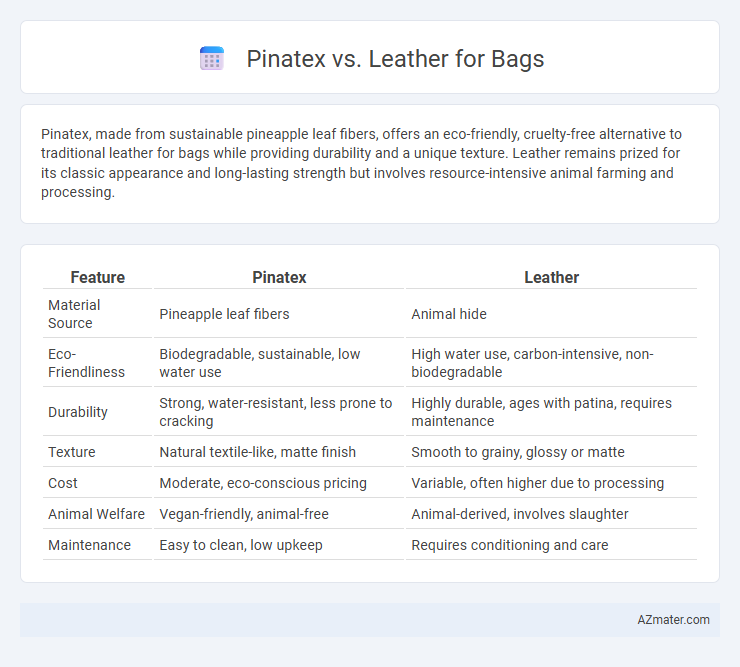Pinatex, made from sustainable pineapple leaf fibers, offers an eco-friendly, cruelty-free alternative to traditional leather for bags while providing durability and a unique texture. Leather remains prized for its classic appearance and long-lasting strength but involves resource-intensive animal farming and processing.
Table of Comparison
| Feature | Pinatex | Leather |
|---|---|---|
| Material Source | Pineapple leaf fibers | Animal hide |
| Eco-Friendliness | Biodegradable, sustainable, low water use | High water use, carbon-intensive, non-biodegradable |
| Durability | Strong, water-resistant, less prone to cracking | Highly durable, ages with patina, requires maintenance |
| Texture | Natural textile-like, matte finish | Smooth to grainy, glossy or matte |
| Cost | Moderate, eco-conscious pricing | Variable, often higher due to processing |
| Animal Welfare | Vegan-friendly, animal-free | Animal-derived, involves slaughter |
| Maintenance | Easy to clean, low upkeep | Requires conditioning and care |
Introduction to Piñatex and Leather
Pinatex is an innovative, sustainable material made from pineapple leaf fibers, offering an eco-friendly alternative to traditional leather with a lower environmental footprint and biodegradable properties. Leather, derived from animal hides through tanning processes, is prized for its durability, natural texture, and premium quality but involves significant water use and chemical treatments. Comparing Pinatex and leather highlights the trade-offs between sustainability and the traditional appeal of genuine animal leather in bag manufacturing.
Material Origins and Production Processes
Pinatex is a sustainable, plant-based material made from pineapple leaf fibers, a byproduct of the agricultural industry, offering an eco-friendly alternative to traditional leather that relies on animal hides. Its production involves minimal water use, no pesticides, and lower carbon emissions compared to the extensive chemical tanning and high water consumption in leather manufacturing. Pinatex's renewable source and biodegradable properties contrast sharply with the environmental impact and resource intensity associated with leather bag production.
Environmental Impact Comparison
Pinatex, made from pineapple leaf fibers, offers a sustainable alternative to traditional leather, significantly reducing water consumption and greenhouse gas emissions during production. Leather manufacturing relies heavily on cattle farming, which contributes to deforestation, methane emissions, and high water usage. Choosing Pinatex bags supports lower environmental footprints through biodegradable materials and waste utilization, making it an eco-friendly choice in fashion accessories.
Durability and Longevity
Pinatex, made from pineapple leaf fibers, offers a sustainable alternative to traditional leather with impressive durability suitable for everyday bags, although it is generally less resistant to extreme wear and tear. Genuine leather excels in longevity, often developing a unique patina over time while providing superior strength and water resistance. Both materials require proper care, but leather typically outperforms Pinatex in lifespan and resilience under heavy use.
Aesthetic and Design Flexibility
Pinatex offers a unique, natural texture derived from pineapple leaf fibers, providing designers with a sustainable alternative that enhances a bag's aesthetic appeal through its organic, matte finish. Leather, known for its classic, smooth surface and rich patina, allows for a wide range of finishes, colors, and treatments, ensuring lasting sophistication and design versatility. Pinatex's lightweight and pliable nature supports innovative shapes and styles, while leather's durability and ability to age gracefully offer timeless elegance in luxury bag designs.
Comfort and Texture Differences
Pinatex, derived from pineapple leaf fibers, offers a lightweight, breathable texture that enhances comfort for extended wear compared to traditional leather's denser, less flexible surface. Unlike the smooth and often rigid feel of leather, Pinatex provides a slightly textured, matte finish that adapts gradually to the user's shape, reducing discomfort and stiffness. The natural fibers in Pinatex also contribute to better moisture wicking, making it a more comfortable choice for bags in warm or humid conditions.
Cost and Market Availability
Pinatex offers a cost-effective alternative to traditional leather, often priced 30-50% lower, making it accessible for budget-conscious consumers seeking sustainable materials. Its market availability is expanding rapidly, with numerous brands incorporating Pinatex in their bag collections across Europe and North America. In contrast, leather remains widely available globally but typically commands higher prices due to production costs and processing time.
Ethical Considerations
Pinatex, made from pineapple leaf fibers, offers a sustainable alternative to traditional leather by reducing reliance on animal agriculture and minimizing environmental degradation. Leather production involves significant ethical concerns, including animal welfare issues and chemical-intensive tanning processes that harm ecosystems. Choosing Pinatex supports cruelty-free fashion and promotes circular economy principles by utilizing agricultural waste.
Maintenance and Care Requirements
Pinatex bags require minimal maintenance, needing only occasional wiping with a damp cloth to remove dirt, making them more water-resistant and less prone to staining than traditional leather. Leather bags demand regular conditioning and polishing to prevent cracking and maintain suppleness, as exposure to moisture and sunlight can cause damage over time. Choosing Pinatex reduces long-term care efforts while offering a durable and eco-friendly alternative to leather that ages without significant deterioration.
Future Trends in Sustainable Bag Materials
Pinatex, derived from pineapple leaf fibers, is emerging as a pioneering sustainable alternative to traditional leather in the bag industry, offering biodegradable and cruelty-free properties. Innovations in plant-based materials and biofabrication technologies are driving the shift towards eco-friendly, durable, and recyclable bags, reducing the environmental footprint of fashion accessories. Consumer demand for transparency and ethical production is accelerating the adoption of Pinatex and other regenerative fibers, signaling a long-term trend toward sustainable luxury goods.

Infographic: Piñatex vs Leather for Bag
 azmater.com
azmater.com